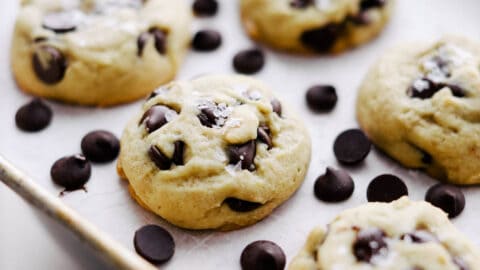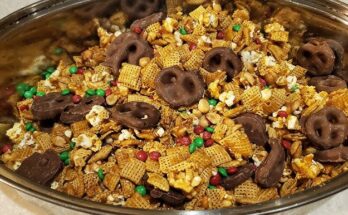Chocolate Chip Cookie Recipe without Brown Sugar: Have you ever craved that perfect batch of homemade chocolate chip cookies, only to realize you’re out of brown sugar? Don’t worry—you can still make irresistible cookies using only white sugar, and the results might surprise you in the best way. While brown sugar adds moisture and a slightly caramel-like flavor, white sugar alone can yield cookies that are crispier on the edges with a light, sweet flavor.
This recipe is perfect for when your pantry is low on ingredients but your sweet tooth won’t take no for an answer. It’s easy, fuss-free, and still gives you that golden, chewy-inside-crispy-outside goodness that cookie dreams are made of.
What’s great about this recipe? You don’t need any fancy ingredients or equipment. Just the basics, a mixing bowl, and a few kitchen staples. And guess what—there’s a secret trick to getting that soft texture even without brown sugar. Intrigued? Let’s get into it.
Ingredients You’ll Need
Basic Ingredients Overview
Before we jump into mixing and baking, let’s gather everything you’ll need. Here’s a list of pantry-friendly ingredients that come together to create a delicious chocolate chip cookie without brown sugar.
- All-purpose flour – 2 and 1/4 cups (280 grams)
- White granulated sugar – 1 cup (200 grams)
- Unsalted butter – 1 cup (2 sticks), softened
- Eggs – 2 large
- Vanilla extract – 2 teaspoons
- Baking soda – 1/2 teaspoon
- Salt – 1/2 teaspoon
- Chocolate chips – 1 and 1/2 cups (semi-sweet or milk)
You don’t need anything complicated—these are all probably sitting in your kitchen right now!
Substitute for Brown Sugar
Since this is a no-brown-sugar recipe, we need to be strategic about moisture and flavor. Brown sugar usually adds moisture because of its molasses content. To mimic this, we can:
- Slightly underbake the cookies to keep the centers soft.
- Add an extra egg yolk for a richer, more tender crumb (optional).
- Increase the butter content slightly if you prefer a chewier texture.
If you have molasses on hand and still want that rich brown sugar flavor, add 1 tablespoon of molasses to the white sugar—voilà, instant brown sugar.
Optional Add-ins for Extra Flavor
Want to level up your cookies? Try one or more of these tasty add-ins:
- Chopped nuts (walnuts, pecans, almonds)
- Sea salt flakes on top after baking
- Cinnamon (1/4 teaspoon for a warm twist)
- White chocolate chips or dark chocolate chunks
- Toffee bits or shredded coconut for a unique texture
These aren’t necessary but can turn a basic cookie into a gourmet treat.
Tools & Equipment You’ll Need
Baking Essentials
Here’s a quick rundown of what you’ll need to get baking:
- Mixing bowls – One large, one medium
- Electric mixer or whisk – For creaming the butter and sugar
- Spatula – For folding ingredients
- Baking sheets – Preferably light-colored and non-stick
- Parchment paper – Keeps the cookies from sticking
- Wire cooling rack – To cool the cookies evenly
Using the right tools makes your baking process smoother and ensures better, more consistent cookies.
Measuring Tools
Accuracy matters when baking. Make sure you have:
- Dry measuring cups
- Liquid measuring cup
- Measuring spoons
- Kitchen scale (optional but excellent for precision)
If your cookies tend to be inconsistent, a kitchen scale might be your new best friend.
Preparation Before You Begin
Preheating the Oven
Always, always preheat your oven. It ensures even baking from the moment your cookies go in. Set it to 350°F (175°C) and let it come to full temperature before you bake.
Pro tip: An oven thermometer can help you confirm your oven’s actual temperature since many home ovens run hot or cold.
Prepping Your Baking Tray
Line your tray with parchment paper or a silicone baking mat. This not only prevents sticking but also ensures your cookies bake evenly without over-browning on the bottom.
Don’t skip this step—it makes cleanup a breeze too.
Bringing Ingredients to Room Temperature
Room temperature ingredients, especially butter and eggs, are key to creating that perfect cookie texture.
- Butter: Leave it out for about 30–45 minutes before baking. It should be soft but not melty.
- Eggs: Let them sit out for 15–20 minutes. This helps them blend better with the butter and sugar.
Why does this matter? Cold ingredients can cause your batter to curdle or mix unevenly, which means unpredictable cookie results. Room temperature ingredients = smooth dough = better cookies.
Step-by-Step Guide to Making Chocolate Chip Cookies Without Brown Sugar
Step 1 – Creaming the Butter and White Sugar
This is where the magic begins. Creaming butter and sugar correctly is the foundation of any great cookie. Here’s how to do it right:
Start with softened butter. Not melted. Not cold. Room temperature butter should give slightly when you press it but still hold its shape.
Place the butter in a large mixing bowl and add the granulated white sugar. Use an electric mixer or stand mixer on medium speed and beat them together for 2–3 minutes. The mixture should become light, fluffy, and pale in color.
Why is this step crucial? Creaming incorporates air into the dough, giving your cookies a light texture while helping them rise evenly during baking. If you skip or rush this, you’ll end up with dense, flat cookies.
Take your time here—it sets the tone for everything that follows.
Step 2 – Adding Eggs and Vanilla Extract
Next, it’s time to build flavor and richness.
Crack in two large eggs, one at a time. Mix well after each addition. This prevents the batter from splitting or becoming too watery. Then, add in 2 teaspoons of pure vanilla extract.
The eggs provide structure, while the vanilla gives your cookies that classic, warm aroma we all love.
Here’s a secret tip: If you want an extra chewy center, toss in one extra egg yolk. Just the yolk—not the white. It’s an optional step, but it adds richness and moisture that really stands out, especially when brown sugar is absent.
Make sure everything is fully mixed at this stage—no streaks of egg or butter should be visible.
Step 3 – Mixing the Dry Ingredients Separately
Grab a separate bowl for the dry ingredients. This step ensures everything is evenly distributed and prevents overmixing later.
Here’s what to combine:
- 2 and 1/4 cups of all-purpose flour
- 1/2 teaspoon of baking soda
- 1/2 teaspoon of salt
Use a whisk or fork to mix them together thoroughly. This helps break up any clumps and evenly spreads the baking soda and salt throughout the flour.
Why is this important? If you were to add the dry ingredients directly into the wet without mixing, you risk uneven distribution, which could lead to salty spots or uneven rising. Nobody wants a cookie that’s half fluffy and half flat.
Optional twist: Add a pinch of cinnamon for warmth, or a tablespoon of cornstarch for extra softness.
Step 4 – Combining Wet and Dry Ingredients
Now, it’s time to bring the dough together.
Slowly add the dry ingredients into the wet mixture, about a third at a time. Mix on low speed or fold gently with a spatula after each addition. You want to stop mixing as soon as no dry flour remains.
This is where most people overdo it. Overmixing the dough will activate the gluten in the flour, which can make your cookies tough instead of tender.
What you’re looking for is a smooth, soft dough that holds its shape but isn’t sticky. If it feels too dry, you can add a tablespoon of milk to loosen it slightly. If it’s too wet, toss in an extra tablespoon of flour.
This is your cookie base—simple, buttery, and ready for chocolate chips.
Step 5 – Folding in the Chocolate Chips
The best part—chocolate!
Add 1 and 1/2 cups of chocolate chips to your dough. Semi-sweet chips are classic, but feel free to get creative. You can mix:
- Milk chocolate for extra sweetness
- Dark chocolate chunks for a richer taste
- White chocolate for contrast
- Mini chips for even distribution
- Chocolate chunks or chopped bars for gooey, uneven pools of chocolate
Fold the chips in with a spatula or wooden spoon. Stir just enough to combine evenly throughout the dough. No mixer needed for this part—too much mixing here can break up the chips or heat the dough.
Bonus tip: Save a few chips to press on top of the cookie dough balls before baking. It makes your cookies look bakery-level beautiful.
Cookie Texture & Taste Without Brown Sugar
What’s Different from Traditional Cookies?
Without brown sugar, your cookies will turn out slightly different—but that’s not a bad thing. Here’s what to expect:
- Texture: You’ll get cookies that are crispier on the outside with a tender, slightly cakier interior.
- Color: They won’t be as dark as traditional cookies but will still have a nice golden hue.
- Taste: Lighter and sweeter, with more focus on the vanilla and butter flavors rather than caramel/molasses notes.
Some people actually prefer this version because it’s less intense and more delicate in flavor. It’s a great option for kids or anyone sensitive to the richness of dark sugars.
How White Sugar Affects Texture
Let’s get nerdy for a second.
White sugar is more refined than brown sugar. It lacks the moisture from molasses, so cookies made with only white sugar spread more and crisp up faster in the oven.
If you like cookies that have crispy edges and soft centers, this recipe nails that balance.
Want them chewier? Add:
- 1 tablespoon of cornstarch
- 1 extra egg yolk
- Or chill the dough for 30 minutes to 1 hour before baking
These tweaks help replicate the moisture typically provided by brown sugar.
Pro Tips for Best Results
Avoiding Common Mistakes
Even the simplest cookie recipes can go sideways if you’re not careful. Here are some common pitfalls to watch out for:
- Using melted butter instead of softened butter: This will cause your cookies to spread too much and lose shape.
- Overmixing the dough: The more you mix, the tougher the cookies become. Once the flour is incorporated, stop.
- Not preheating the oven: Putting cookies into a cold oven can ruin the texture. Always preheat!
- Crowding the baking tray: Leave enough space (at least 2 inches) between each cookie to allow them to spread.
- Skipping the parchment paper: This makes a huge difference in avoiding burnt bottoms and helps with even baking.
- Not measuring accurately: Baking is science. Use the spoon-and-level method for flour or better yet, a kitchen scale.
These are small habits that make a huge difference in turning “just okay” cookies into can’t-stop-eating-them cookies.
Making Them Chewier or Crispier
Here’s where you can customize your cookie texture to match your personal preference:
Want chewier cookies?
- Add 1 extra egg yolk
- Mix in 1 tablespoon of cornstarch
- Chill the dough before baking
- Bake slightly under (9–10 minutes)
Want crispier cookies?
- Use less flour (about 2 tablespoons less)
- Flatten the dough balls before baking
- Bake longer (11–12 minutes)
- Let them cool fully on a wire rack
You can even make a batch and divide it—bake half for a chewy batch and the rest for a crispy batch. Win-win.
Storage Instructions
How to Store Baked Cookies
Once your cookies have cooled completely, it’s time to store them the right way.
- Airtight container: Store cookies in a sealed container at room temperature.
- Shelf life: They’ll stay fresh for up to 5 days—though they usually disappear much faster!
- Add a slice of bread: This old trick works wonders. A slice of white bread in the container keeps the cookies soft by absorbing excess air moisture.
If your cookies start to get stale, pop them in the microwave for 5–10 seconds and they’ll taste fresh out of the oven.
Freezing Dough for Later Use
Want fresh-baked cookies anytime you want? Freeze the dough!
Here’s how:
- Scoop the dough into balls.
- Place them on a baking sheet lined with parchment paper.
- Freeze until solid (about 1–2 hours).
- Transfer to a zip-top freezer bag or airtight container.
You can freeze cookie dough for up to 3 months. When you’re ready to bake, just pop them straight into the oven—no thawing needed. Add an extra 1–2 minutes to the baking time.
Perfect for sudden cravings, unexpected guests, or just a bad day that needs cookies fast.
Variations of the Recipe
Sugar-Free Version
Cutting back on sugar? You can still enjoy these cookies with a few smart swaps:
- Replace white sugar with a sugar substitute like erythritol or monk fruit (use a 1:1 ratio brand).
- Skip the chocolate chips or use sugar-free chocolate.
Note: Sugar substitutes may affect the texture slightly, making the cookies more cake-like or less chewy, but the flavor will still be solid. You might need to do a little experimenting to find your favorite balance.
Gluten-Free Option
Going gluten-free? No problem. Here’s what to do:
- Substitute the all-purpose flour with a 1:1 gluten-free baking blend.
- Add 1/2 teaspoon of xanthan gum if your flour blend doesn’t already include it. This mimics the binding power of gluten.
The rest of the recipe stays the same. Just make sure your chocolate chips are also gluten-free—some brands may contain traces of wheat.
Vegan Twist
You can also make these cookies 100% plant-based:
- Replace butter with vegan margarine or coconut oil.
- Use flax eggs instead of regular eggs (1 flax egg = 1 tbsp ground flax + 3 tbsp water, let sit for 5 mins).
- Choose dairy-free chocolate chips.
These substitutions may change the texture slightly (a bit more cakey or tender), but they’ll still be delicious, cruelty-free, and totally satisfying.
Nutrition Information
Estimated Calories per Cookie
Depending on the size and add-ins, each cookie contains:
| Component | Estimated Value (Per Cookie) |
|---|---|
| Calories | 180–210 kcal |
| Total Fat | 9–11g |
| Saturated Fat | 5–6g |
| Carbohydrates | 26–30g |
| Sugar | 18–22g |
| Protein | 2–3g |
| Fiber | 0.5–1g |
This is based on a standard 2-tablespoon cookie. If you’re watching your intake, try making smaller cookies or reducing the chocolate chips a bit.
Key Nutrients Breakdown
These cookies also offer small doses of:
- Iron – From chocolate chips and flour
- Calcium – Especially if you use chocolate with added minerals
- Vitamin A – From butter
Of course, cookies are a treat, not a health food—but hey, knowing what’s inside helps you make informed choices!
FAQs about Chocolate Chip Cookie Recipe without Brown Sugar
1. Can I use honey instead of sugar in this recipe?
You technically can, but it will change the texture and flavor significantly. Honey adds more moisture and a denser, cakier result. If you try it, reduce other liquids slightly and lower the oven temperature by 25°F. But for a true cookie texture, white sugar is still best.
2. Why did my cookies turn out flat?
Flat cookies usually happen because of melted butter, overmixing, or placing dough on a warm tray. Make sure your butter is just softened, chill your dough if needed, and always use a cool baking sheet for each new batch.
3. How do I know when the cookies are done?
Check the edges—they should be lightly golden and set. The centers might still look soft or a bit underbaked, and that’s perfect! They’ll continue baking slightly from residual heat as they cool on the tray. Usually, 10–12 minutes at 350°F does the trick.
4. Can I chill the dough overnight?
Absolutely. Chilling the dough for a few hours—or even overnight—helps the flavors develop and can prevent spreading. Just let the dough sit at room temperature for 10 minutes before scooping if it gets too firm.
5. What kind of chocolate chips work best?
Semi-sweet chocolate chips are the go-to for a balanced sweetness, but you can use dark, milk, or even white chocolate depending on your taste. Chopped chocolate bars also work and give those lovely melty pools of chocolate.
Conclusion
This no-brown-sugar version brings out the vanilla and buttery richness in every bite. The crisp edges and soft centers give that perfect texture contrast we all crave in a cookie. Whether you’re baking late at night with a sweet tooth emergency, or just experimenting in the kitchen, this recipe will never let you down.
What makes this recipe a keeper? It’s simple, adaptable, and totally pantry-friendly. Plus, once you master this version, you can riff on it endlessly with nuts, spices, or even turning it into cookie bars or ice cream sandwiches.
So preheat that oven, grab a mixing bowl, and treat yourself—you deserve it. And once you’ve had one, we guarantee… you’re going back for another.


